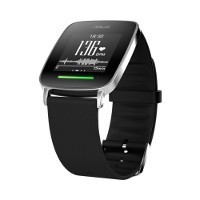

Health and fitness has become one of the busiest categories of tech gadgets in recent times, with companies as diverse as Nike, Garmin and Apple all making plays in the lucrative market for smartwatches and fitness bands.
Maybe this particular category has been pushed by all those baby boomer tech execs getting to grips with their mortality?
Read more: How Fitbit is disrupting traditional business models
Of course the hype surrounding this category has shifted up a notch since the release of Apple Watch, but many consumers are still sussing out whether they really need all that Million-Dollar Man style monitoring and data when they can just use fitness apps on their smartphone instead.
One of the newest entrants in this increasingly crowded marketplace is Asus, with its ZenWatch… No, hang on a second, this is the VivoWatch.
So what exactly does the VivoWatch offer that the ZenWatch doesn’t, other than being cheaper?
Hardware and features
The Asus VivoWatch runs its own Android-based operating system and is powered by a low-powered processor, which aids its 10-day battery life – one of the main selling points of the device.
The VivoWatch has an IP67 water resistance rating and the screen has a resolution of 128×128 pixels. The display is made of Corning Gorilla Glass 3.
It has 3-axis accelerometer, optical heart rate sensor with ASUS VivoPulse technology and UV sensor. It weighs 50 grams.
What’s the consensus?
Nicole Arce at Tech Times writes the VivoWatch is comparable in looks to the ZenWatch but maybe lacking a little polish where it counts:
The Vivo Watch also appears to adopt its older brother’s square-circle display, although the bezel appears to be thinner than on the ZenWatch. Asus says it has a standard 22 mm replaceable strap that, from the looks of it, appears to be made from some kind of black synthetic material. It’s not leather like the one on the ZenWatch, that’s for sure, but users can easily swap out the strap for something else if they want. You can also change straps on the ZenWatch. The only thing we find amiss on the Vivo Watch is the not-so-subtle Asus logo sitting dead center of the top of the screen.
Richard Lai at Engadget says the device’s battery life is one of its strong points:
For the sake of extending the battery life to up to 10 days, the VivoWatch uses a combination of ASUS’ self-developed, real-time OS called KoodOS; a low-power processor; and a 1.28-inch, 128 x 128-pixel, low-power, black-and-white memory LCD. The screen works very well under sunlight, and it’s also backlit for indoor usage. To juice up the watch, just snap the small charging cradle onto the back of the body and leave it there for between one to two hours.
The reviewer at Mobile Geeks, meanwhile, seemed smitten by the watch’s design:
The Vivowatch is a beautiful device, I can see why ASUS decided to launch it at Milan Design Week, its unibody stainless steel chassis is sleek and polished looking and the display is crisp with elegant undertones due to its highly reflective nature. Its design offers up a combination of fitness tracker with the elements of a traditional watch. It’s easy to use interface and simple clean watch design will have wide appeal not only to early adopters but to those of all ages who are looking to incorporate fitness and lifestyle tracking into their lives.
Should I get one?
The VivoWatch is essentially a cheaper and more fitness-oriented device than its Asus counterpart the ZenWatch. The marketing tagline for the watch seems to be pitched at the stressed tech exec on the verge of a mid-life health crisis: “The pulse of life: A watch to care for you and your family.”
Considering the vast range of fitness devices out there, it is hard to see exactly what market niche this new smartwatch/fitness device hybrid will satisfy. It appears to be a solid device but fairly run-of-the-treadmill when compared to its more illustrious competition.


COMMENTS
SmartCompany is committed to hosting lively discussions. Help us keep the conversation useful, interesting and welcoming. We aim to publish comments quickly in the interest of promoting robust conversation, but we’re a small team and we deploy filters to protect against legal risk. Occasionally your comment may be held up while it is being reviewed, but we’re working as fast as we can to keep the conversation rolling.
The SmartCompany comment section is members-only content. Please subscribe to leave a comment.
The SmartCompany comment section is members-only content. Please login to leave a comment.